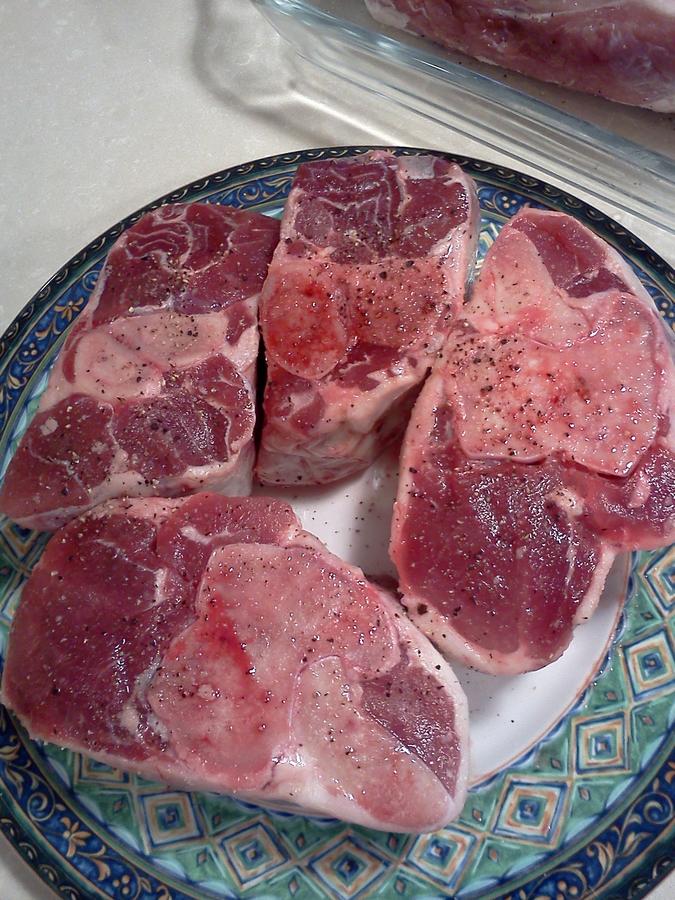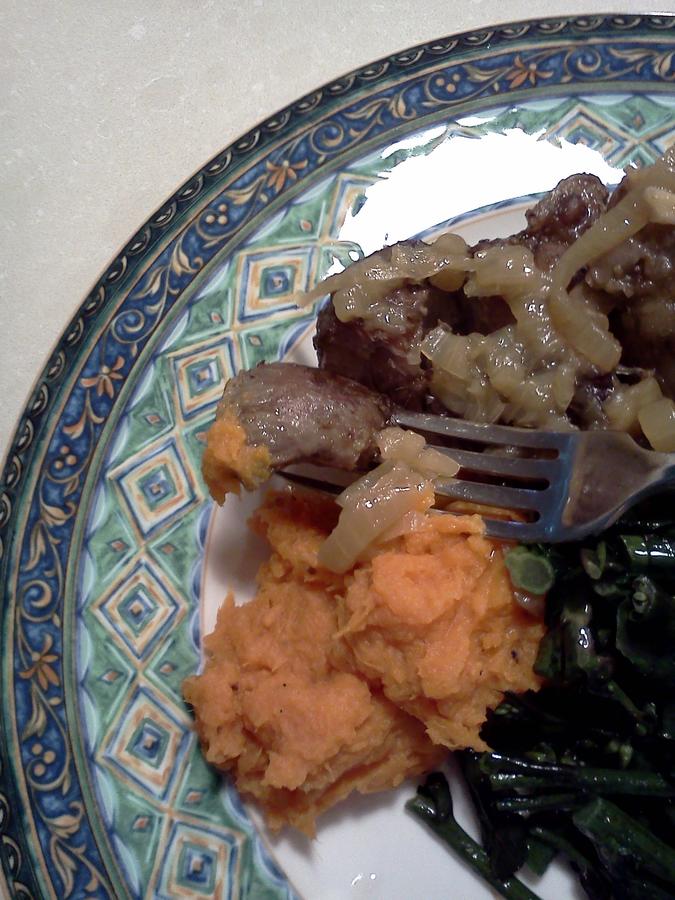- Nov 15, 2012
- 1,025
- 107
Hi Nose-To-Tail folks,
Pork shanks probably don't really qualify as Nose-To-Tail, as they are pretty mainstream. But this is one of me and my husband's favorite braising dishes, so I thought I'd share it anyway.
For those who aren't familiar with it, the pork shank comes from the same part of the pig as the hock: it is from between the picnic shoulder and foot, or between the leg/ham and the foot. I believe that the terms "shank" and "hock" are interchangeable (please correct me if I'm wrong), although I generally hear it referred to as "shank" when left fresh, and as "hock" when cured. The pork shank has got to be one of the most undervalued cuts on the pig. It is cheap, has great flavor, and when slowly cooked with moist heat, becomes falling-apart tender. We prefer to braise it with the skin-on because the skin has lots of collagen, which breaks down into gelatin when cooked. This gives the braising liquid a silky feel. Plus, pig skin is just delicious. Cooked gently until soft and pliable? Delicious. Deep fried until crispy? Delicious. Cured and used to make a football? Delici...well, maybe not. ;-)
Here are our cross-cut shanks. These come from a local farmer who pasture-raises his pigs. Can you believe the color? As I said, we would prefer these skin-on, but I got a bunch of them at a sale price, and the skin had already been removed.
The ingredients: cross-cut pork shanks, 2 medium onions (sliced), 4 garlic cloves (sliced), 2 bay leaves, a few sprigs of fresh thyme, 1/2 cup apple cider, 1/4 cup apple cider vinegar.
You could substitute pork shoulder for the shank. You could increase the amount of cider and cider vinegar if you want.
First, I coated the braising pan with extra virgin olive oil, then heated it up. Salt and pepper the pork shanks, then brown them. Try to get a nice sear for best flavor. Preheat your oven to 325 deg F while you are doing this.
When browned on both sides, remove and set aside. Add your sliced onions to the same pan. Add a little more oil if the pan is already dry. Caramelize the onions. This might take 10-15 minutes. You might need to lower the heat to caramelize without burning the onions. During the last minute or so, add maybe 3/4 tsp of salt, the sliced garlic, the bay leaves, and the thyme sprigs.
The moisture from the onions will have already started to deglaze the pan while you were caramelizing the onions. But after the onions are ready, then add your cider and cider vinegar to the pan to deglaze the pan. You can probably see that I've forgotten to put in the bay leaves and thyme. They should be in there. But apparently I can't take pictures and simultaneously actually cook. Coordinated, I am not.
Bring the liquid up to a low boil. Nestle the pork shanks in the liquid. Braising recipes usually say that the liquid should reach about halfway up the side of meat.
Cover tightly and put in your preheated oven. Braise the pork until it is very tender. This takes about 2 1/2 - 3 hours, and you can flip the shanks over a couple of times. When the pork is fork tender and falling off the bone, remove it and set aside. The braising liquid can be defatted (if needed) and then reduced. Serve the pork shanks with the braising liquid as a sauce. We love it.
Thanks for looking!
Clarissa
Pork shanks probably don't really qualify as Nose-To-Tail, as they are pretty mainstream. But this is one of me and my husband's favorite braising dishes, so I thought I'd share it anyway.
For those who aren't familiar with it, the pork shank comes from the same part of the pig as the hock: it is from between the picnic shoulder and foot, or between the leg/ham and the foot. I believe that the terms "shank" and "hock" are interchangeable (please correct me if I'm wrong), although I generally hear it referred to as "shank" when left fresh, and as "hock" when cured. The pork shank has got to be one of the most undervalued cuts on the pig. It is cheap, has great flavor, and when slowly cooked with moist heat, becomes falling-apart tender. We prefer to braise it with the skin-on because the skin has lots of collagen, which breaks down into gelatin when cooked. This gives the braising liquid a silky feel. Plus, pig skin is just delicious. Cooked gently until soft and pliable? Delicious. Deep fried until crispy? Delicious. Cured and used to make a football? Delici...well, maybe not. ;-)
Here are our cross-cut shanks. These come from a local farmer who pasture-raises his pigs. Can you believe the color? As I said, we would prefer these skin-on, but I got a bunch of them at a sale price, and the skin had already been removed.
The ingredients: cross-cut pork shanks, 2 medium onions (sliced), 4 garlic cloves (sliced), 2 bay leaves, a few sprigs of fresh thyme, 1/2 cup apple cider, 1/4 cup apple cider vinegar.
You could substitute pork shoulder for the shank. You could increase the amount of cider and cider vinegar if you want.
First, I coated the braising pan with extra virgin olive oil, then heated it up. Salt and pepper the pork shanks, then brown them. Try to get a nice sear for best flavor. Preheat your oven to 325 deg F while you are doing this.
When browned on both sides, remove and set aside. Add your sliced onions to the same pan. Add a little more oil if the pan is already dry. Caramelize the onions. This might take 10-15 minutes. You might need to lower the heat to caramelize without burning the onions. During the last minute or so, add maybe 3/4 tsp of salt, the sliced garlic, the bay leaves, and the thyme sprigs.
The moisture from the onions will have already started to deglaze the pan while you were caramelizing the onions. But after the onions are ready, then add your cider and cider vinegar to the pan to deglaze the pan. You can probably see that I've forgotten to put in the bay leaves and thyme. They should be in there. But apparently I can't take pictures and simultaneously actually cook. Coordinated, I am not.
Bring the liquid up to a low boil. Nestle the pork shanks in the liquid. Braising recipes usually say that the liquid should reach about halfway up the side of meat.
Cover tightly and put in your preheated oven. Braise the pork until it is very tender. This takes about 2 1/2 - 3 hours, and you can flip the shanks over a couple of times. When the pork is fork tender and falling off the bone, remove it and set aside. The braising liquid can be defatted (if needed) and then reduced. Serve the pork shanks with the braising liquid as a sauce. We love it.
Thanks for looking!
Clarissa
Last edited:















